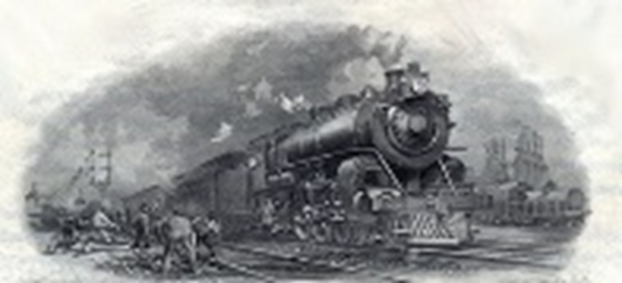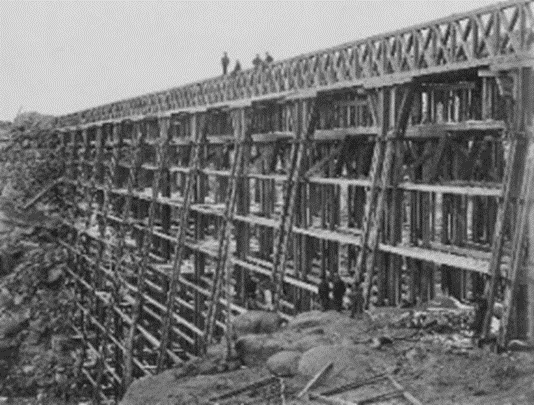The History of the Railroad Article 12

Bridge Basics Part 1
You could say the first bridge in the United States was when a tree was cut down and placed over a small creek to, they walk across it. The trunk is the beam, with the banks being the abutments which support the beam.
Bridges were being made for horse and buggy transportation long before for railway transportation.1
With Great Briton and Europe inventing most of the railroad technology, bridge technology is the one item that is solely attributed to America.
It was in 1697 that the oldest surviving stone arch in America was completed. It was built over the Pennypack Creek near Philadelphia. It was called the beginning of the stone era in America.

Pennypack Creek Stone Arch Bridge Philadelphia, Pennsylvania
Eliott, Joseph, Public domain, via Wikimedia Commons
The Pennypack Creek Bridge in Philadelphia is a three span stone arch bridge that was built in 1697, then paved in 1803.
In 1897, in advancement with inventions at the time, it was widened to accommodate street cars. 2
Prior to the iron and steel bridges that we are so accustomed to today, the earliest bridges were constructed with stone and wood. If you take a look at some of the earliest bridges, there is probably no way you would have ridden a train across one.

Original Dale Creek Wooden Bridge
Andrew J Russel, Wiki Commons Public Domain
The original Dale Creek Bride was wooden. As the first train crossed over on April 23, 1868. The newly constructed trestle swayed in the strong winds. The construction crew set to shore up the trestle. As they were working on it for the next couple of days, two workmen fell to their deaths.
Then still as the trains crossed over the bridge, the wooden structure would still sway under the repeated train crossings. 3
When a bridge is constructed, the engineer must allow for the forces that come with trains passing over them. There are concentrated impacts as the train moves onto a bridge. Also, the stopping and starting of the train while on the bridge causes a drag or a push effect. Due to these forces the bridge must be heavier than a highway bridge of equal length.
Also, with the advancement of locomotive technology, the axle loading increases. Along with the axle loading, with the speed of the train increasing it causes the need for the bridges being required to be strengthened also.
By strengthening the bridge, you also minimize maintenance cost on the locomotives as well as the. 4
With the escalation in the construction of the railroad and the advancement of railroad technology, it kept the engineers up at night.
The main objective of a railroad bridge is to support the locomotive and its load over an obstruction. An obstruction in the form of a river, gorge, or a road.
The intricate design of the bridges became exceedingly more important. As the mileage increased across the nation, the number of bridges needed increased exponentially.
Timber trestles, bridges and those stones were the common choice in the 19th century. The abundance of timber made wood trestles the choice for most railroads. Stone archways cost a lot of money but timber trestles and bridges were only meant to be temporary. With the wood being untreated, they would only last approximately 20 years.


Trestle Bridge, Whiteside, Tennessee
The U.S. National Archives, Public domain, via Wikimedia Commons
As you can see, the intricate design of this trestle in mindboggling to the novice. This design of a number of short spans, held up by the ridged tripod looking frames was used extensively in the 19th century.
Because the trestle was built in such a moist area, with river waters being in constant contact with it. You can see why twenty years is a conservative estimate of its longevity. 5
Another element caused an adverse effect on the wooden trestle or bridge. Locomotives produced sparks and hot embers, which in turn would catch the wooden structure on fire.
With that said, wooden bridges were the quick way to open a railroad. With the abundance of timber, it was the cheapest and fastest to open a branch or an entire line. While the railroad was being built, it was not making any money. So, this is a prime incentive to get the line up and running, hauling freight and passengers.
On the Belmont Branch of the St. Louis, Iron Mountain Railway, branched off the main line at Bismarck, Missouri to DeLassus. After the completion of laying the track that far, trains began running the short distance hauling freight and passengers. while the rest of the track was being laid.
A lot of railroad startups failed due to not getting cash flowing as soon as possible. Unforeseen costs and the rising cost of materials could sink an upstart fast.
The next article we will look at the different types of bridges.
References:
- Bridge Basics What Goes Up Shouldn’t Come Down. By Tony Koester
- Historic Bridges, Bridge Browser, Pennypack Creek Bridge; https://historicbridges.org/bridges/browser/?bridgebrowser=pennsylvania/frankford/
- Gardner, Mark L. (1988). "Dale Creek Crossing". Annals of Wyoming.
60 (1). Wyoming State Press: 3–5.
- Encyclopedia Britanica, Railroad Track and Roadway Bridges
- Train Conductor-Railroad Bridges, Old and New